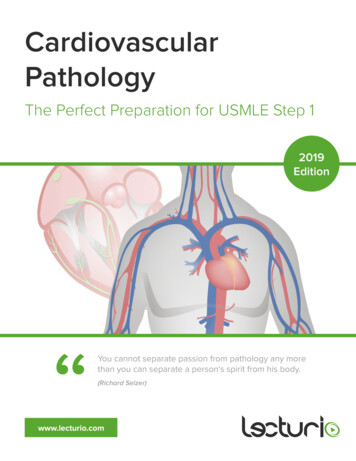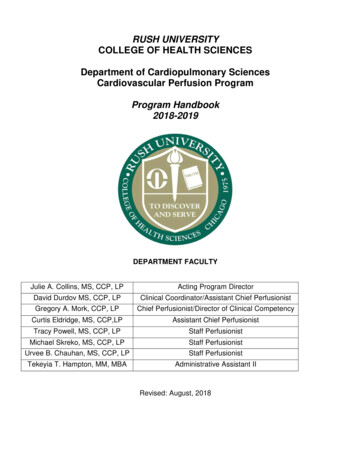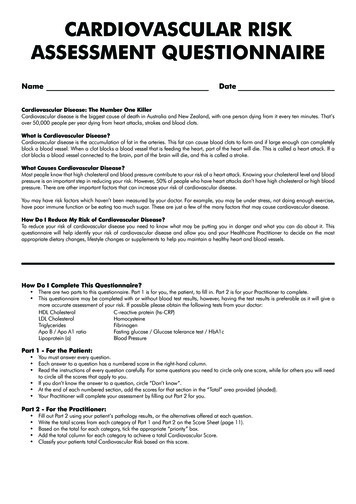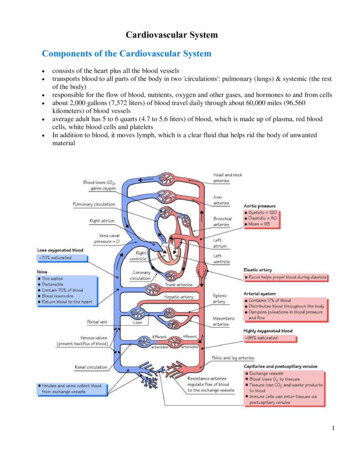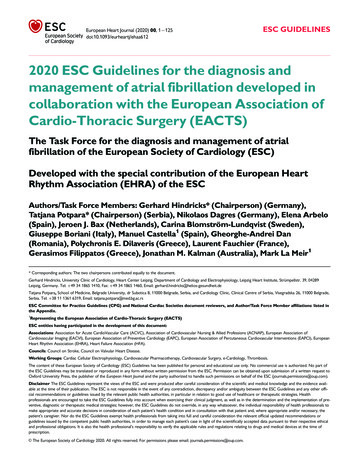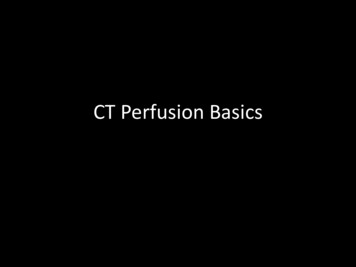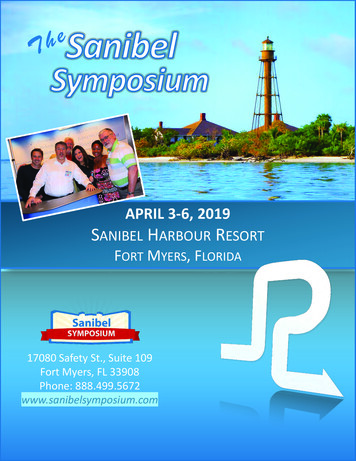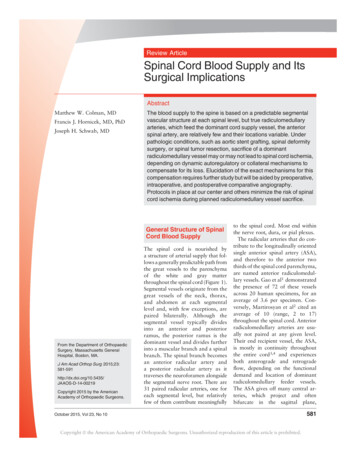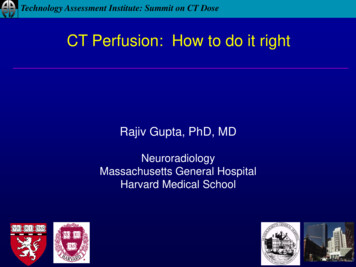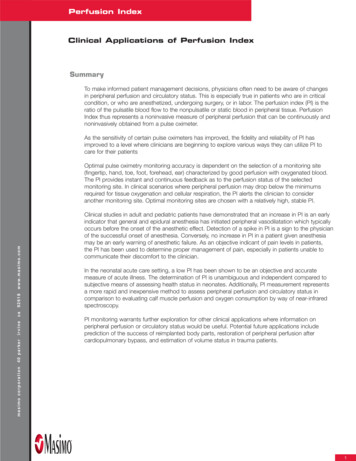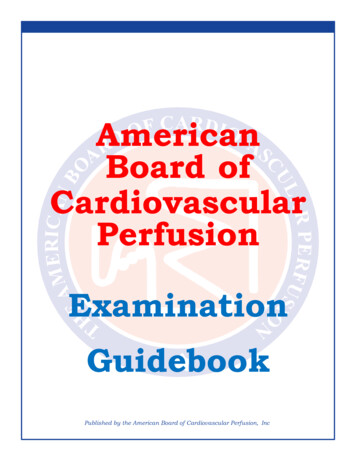
Transcription
AmericanBoard shed by the American Board of Cardiovascular Perfusion, Inc
A Guidebook for theExamination Process of theAmerican Board of Cardiovascular PerfusionNational OfficeAmerican Board of Cardiovascular Perfusion2903 Arlington LoopHattiesburg, MS 39401(601) 268-2221Fax (601) 268-2229www.abcp.org
1Mission StatementThe American Board of Cardiovascular Perfusion acknowledges that peer recognition isresponsible for the quality assurance involved in the credentialing process that is available to theperfusion community. The American Board of Cardiovascular Perfusion respects its position andresponsibility in that process and acknowledges the many Certified Clinical Perfusionists,educational program directors, collaborating organizations, and others in the perfusion communityfor their continued support of the American Board of Cardiovascular Perfusion and its credentialingprocess. In accordance with its commitment to establish and maintain interactive communicationwith individuals, institutions, and organizations, the American Board of Cardiovascular Perfusionrespectfully submits the following Mission Statement to guide its growth and development.The American Board of Cardiovascular Perfusion willstrive to develop and maintain qualitystandards in cardiovascular perfusion thatpromote safety and protection of thepublic. These standards will include theattainment and enhancement of knowledge, skills,and ethical professional conduct of CertifiedClinical Perfusionists by supporting preservice andinservice education. This support will emanatefrom the design, implementation, andadministration of the credentialing process.Additionally, this support will includestimulation of innovative educationalactivities and promotion of ethicalprofessional development.The American Board of Cardiovascular Perfusion, inacknowledging the leadership role of a professionalcredentialing body, will aspire to provide exemplary,responsible, and ethical leadership in all of itsendeavors.
8Introduction to the ABCP Examination ProcessPURPOSE AND DESCRIPTION OF THEABCP EXAMINATION PROCESSThe purpose of the American Board ofCardiovascular Perfusion (ABCP) examinationprocess is to provide certification in cardiovascularperfusion as evidence that a perfusionist’squalifications for operation of extracorporealequipment are recognized by their peers.Application to the ABCP certification process isvoluntary. Certification is not intended to definerequirements for employment, to gain specialrecognition or privileges, to define the scope ofextracorporeal circulation, or to state who may ormay not engage in cardiovascular perfusion.The examination is administered in two parts. PartI, the Perfusion Basic Science Examination (PBSE), is a220-item, multiple-choice examination designed tocover perfusion basic science and cardiopulmonarybypass. Part II, the Clinical Applications in PerfusionExamination (CAPE), is also of a multiple-choice format, in which a series of clinical scenarios arepresented, each with a series of questions. Thenumber of questions on Part II may vary from 200to 230, depending on the scenarios used.ELIGIBILITY REQUIREMENTSApplicants for the Perfusion Basic Science Examinationmay be currently enrolled in an accredited Schoolof Cardiovascular Perfusion and anticipating graduation at least four weeks prior to the date of theexamination or have graduated from an accredited School of Cardiovascular Perfusion. Applicantsfor the PBSE must submit or arrange for submissionof (1) a Clinical Education Record documenting 75cardiopulmonary bypass (CPB) proceduresperformed prior to graduation while in theaccredited school of perfusion, (2) a current,official transcript of credits from the educationalinstitution documenting graduation, and (3) astatement of satisfactory clinical competency fromthe Clinical Competency Committee Chairperson.Applicants for the Clinical Applications in PerfusionExamination must have conducted a minimum of 40additional independent clinical perfusions after graduation.Those candidates meeting all requirementsfor both examinations may make applicationto sit for both examinations at the same site.PERFUSION BASIC SCIENCE EXAMINATION(PBSE) APPLICATIONPROCEDUREApplicants are required to submit the following byJuly 1 for the fall examination or December 1 forthe following spring examination:1. a notarized PBSE application completed infull; (Applications available:www.abcp.org For Students Certification Application Forms)2. a fee of 350.00 in the form of a bankdraft, money order, personal check,or credit card made payable to theAmerican Board of CardiovascularPerfusion. Applicants MUST:(1) make fees payable in U.S. Dollars;(2) add a 5.00 service charge (if residingoutside of the U.S.A.); and(3) add a 10.00 credit card processing fee ifusing a credit card for payment.Applications must be postmarked no laterthan midnight on July 1 or December 1 andmust be sent by certified mail (returnreceipt requested.)Applicants must submit or arrange for submissionof the following:1. The Clinical Education Recorddocumenting seventy-five (75)cardiopulmonary bypass (CPB) proceduresperformed prior to graduation. A minimumof 10 clinical pediatric cases requiringcardiopulmonary bypass must be observedor performed for the certification process.Pediatric cases performed may counttoward the 75-minimum cardiopulmonarybypass case requirement; observationalpediatric cases do not count toward the75-minimum cardiopulmonary bypass caserequirement;2. a current, official transcript of credits fromthe accredited school of perfusion, indicatingdate of graduation; and3. a statement of satisfactory clinicalcompetency from the Clinical CompetencyCommittee Chairperson or programdirector at the accredited school ofperfusion.These items must be on file in the NationalOffice at least four weeks prior to theexamination and will be verified. Eligibility toregister with Pearson Vue is contingent upon
3all documentation being received in theNational Office prior to registration.NOTE: Candidates retaking the examination areNOT required to resubmit or arrange forresubmission of the Clinical Education Record,the official transcript, or the Clinical CompetencyStatement. These Items will remain on file fromthe previous application.CLINICAL APPLICATIONS IN PERFUSIONEXAMINATION (CAPE) APPLICATIONPROCEDUREApplicants are required to submit the following byJuly 1 for the fall examination or December 1 forthe following spring examination:1. a notarized CAPE application completed in full;(Applications available: www.abcp.org ForStudents Certification Application &Recertification Forms);2. a fee of 350.00 in the form of a bank draft,money order, personal check, or creditcard made payable to the American Board ofCardiovascular Perfusion.3. Applicants MUST:(1)make fees payable in U.S. Dollars,(2)add a 5.00 service charge (ifresiding outside of the U.S.A.); and(3)add a 10.00 credit card processingfee if using a credit card for payment.Applications must be postmarked no laterthan midnight July 1 for the fall examinationor December 1 for the spring examinationand must be sent by certified mail (returnreceipt requested).Applicants must submit or arrange for submission of thefollowing:1. a Case Summary documenting forty (40)independent Primary Clinical PerfusionActivities (PCPA) performed aftergraduation. Activities are defined on TableA Primary Clinical Perfusion ActivitiesCAPE (PCPA) that may be found on page5.This item must be on file in the NationalOffice at least four weeks prior to the examination and will be verified. Eligibility toregister with Pearson Vue is contingent uponall documentation being received in theNational Office prior to registration.NOTE: Candidates retaking the examination areNOT required to resubmit or arrange forresubmission of the Case Summary. This itemremains on file from the previous application.LATE APPLICATIONSApplicants submitting applications for eitherportion of the certification examination, up to thirtydays following the deadline, will be assessed a latefiling fee of 75.00. No applications will beaccepted after the LATE FILING DATE.
8Table A CAPE Primary Clinical Perfusion Activities (CAPE-PCPA)for Reporting Independent Cases for the CAPEPrimary Clinical PerfusionClinical DefinitionActivities (PCPA)1PA CCP candidate who is the primaryoperator of the heart-lung machine usedCardiopulmonary Bypassduring cardiac surgery and other surgeries(CPB), Primarythat require extracorporeal circulationwhich is used to manage the patient'sphysiological status2PA CCP candidate who is the primaryoperator of Extra-Corporeal MembraneExtra-Corporeal Membrane Oxygenation (ECMO) circuit thatOxygenation (ECMO),provides life support for respiratoryPrimaryand/or cardiac failure.3PIsolated Limb/OrganPerfusion, Primary4PVeno-Venous or Left HeartBypass, Primary5PVentricular Assist DeviceCore ElementsBlood pump, reservoir, heat exchanger,oxygenator, extracorporeal circuit usedaccordingly with hemodynamic/lab valuemonitoring.Extracorporeal circuit, oxygenator, heatexchanger used accordingly withhemodynamic/lab value monitoring. Foreach ECMO case, one case credit per 24hours will be awarded for initiating andbedside managing ECMO (4-hourminimum) or bedside managing (6-hourminimum). No simultaneous credit will beawarded for managing multiple ECMOpatients in this time period.A CCP candidate who is the primaryoperator of an extracorporeal device usedto deliver anticancer drugs directly to anarm, leg, or organ that manages thepatient's physiological status or (2) theprimary operator of an extracorporealdevice, including an oxygenator/deoxygenator and pump, used to manage thephysiologic state of isolated and separatedhuman organs from the body, for potentialtransplant opportunities.A CCP candidate who is the primaryoperator of an extracorporeal device usedto perfuse specific vascular regions withinthe circulatory system or recirculatevenous blood for purposes such asclot/tissue removal.Reservoir, blood pump, heat exchanger,oxygenator, extracorporeal circuit usedaccordingly with hemodynamic,temperature, and lab value monitoring.A CCP candidate who is the primaryoperator of the Ventricular Assist Device(VAD) that provides cardiac support forthe failing heart.For each VAD case, one case credit per 24hours will be awarded for initiating andmanaging VAD or bedside managing (6hour minimum). No simultaneous creditwill be awarded for managing multipleVAD patients in this time period.Blood pump, extracorporeal circuit usedaccordingly with hemodynamic/lab valuemonitoring.
5Computer-Based TestingThe Perfusion Basic Science Examination (PBSE)and the Clinical Applications in PerfusionExamination (CAPE) are administered at PearsonVue testing centers throughout the United States,U.S. Territories, Canada, and various sitesoutside the U.S. and Canada. The examinationwindows are in March and October; the exact timeframe will be posted to our website(www.abcp.org) and sent to each examinee byemail. Examinations may be taken during that timeperiod only. The duration of each examination isfour hours and both examinations may be taken onthe same day, depending on test site availability.Prior to registering for the examination(s) withPearson Vue, the examinee must complete theABCP application process and meet the ABCPdeadlines. To complete the application process, thefollowing items must be on file in the ABCP NationalOffice: a completed application form with appropriatefee(s); an official transcript; the clinical competency form signed by the student and the program director; and the clinical education record that applies to theexamination(s).Once the application process has been completed,the ABCP National Office will provide you with anexamination ID number, and you may visit thePearson Vue websitewww.pearsonvue.com/abcp/ to create anaccount. You may schedule, cancel, orreschedule your test online. Available test sites,times, and locations will be identified uponscheduling.In order to register online, you must have a validemail address. Examinees can also registerusing the Pearson Vue telephone system 888839-7768 in U.S./Canada (Monday–Friday 7a.m. to 7 p.m. U.S. Central Time). In order toensure the best selection of testing sites and times,please register as soon as possible after beingnotified by the ABCP National Office that you havebeen accepted for the examination(s).At the testing center, you will be required topresent two forms of original (no photocopies ordigital copies) valid, non-expired, governmentissued photo IDs with a signature (e.g., driver’slicense, passport, military ID).If you are testing within your country of citizenship,you must present two IDs to include either a validpassport, driver’s license, national ID, or militaryID. The name on the Pearson Vue reservationmust match the name on your IDs or you maybe denied admission. For example, if yourdriver’s license is issued to Robert L. Doe andyou have registered with ABCP using yournickname Larry Doe, you will be deniedadmission. Contact the ABCP National Officeimmediately if there is a discrepancy betweenthe name on the reservation and your photo ID.If you are testing outside of your country ofcitizenship, you must present a valid passport fromyour country of origin as one of the two requiredIDs.You may cancel or reschedule up to 24 hoursbefore your appointment at no cost (via online orphone). Pearson Vue will send you a confirmationemail each time you reschedule or cancel anappointment. There are multiple steps toreschedule online, so be sure that you complete allsteps until the “Your appointment is rescheduled”screen is displayed. If you do not receive aconfirmation email, please recheck the status ofyour appointment.If you fail to cancel 24 hours prior to yourappointment, or if you miss your appointment,show up late, or provide inadequate identification,you will not be able to make a new appointmentwithout paying the ABCP exam retest fee.Additional information is available via the linksprovided in your email from Pearson Vue:Examination results will be provided at the end ofeach testing session. Certification status will beprovided by the ABCP National Office.
8Examination InformationPRACTICE-RELATED CONTENTThe ABCP examinations are criterion-referenced,based on an ongoing task/practice-relatedanalysis using recognized procedures for taskanalysis and examination development. TheABCP Knowledge Base is designed to cover thescope of perfusion practice required of aminimally certifiable perfusionist. Testspecifications are derived from the currentpractice-related knowledge base using thecontent objectives and covering the six levels ofcognitive skills described in Bloom’s Taxonomy.The questions on the examinations are validatedannually using both qualitative and quantitativeitem analysis procedures including currentpractice relevance, level of difficulty and an itemdiscrimination index.The ABCP Knowledge Base is revalidated, everyfive to seven years by practicing CCPs who areasked to respond to each item on the knowledgebase according to the frequency with which eachitem is used and the importance of each forpublic protection. The responses aresubsequently reviewed and the document isrevised and revalidated in accordance with thedata from the survey.THE ITEM POOL, KNOWLEDGEBASE, AND EXAMINATION AREINDIVIDUALLYCOPYRIGHTED;THEREFORE, ANY DISTRIBUTIONOF THE EXAMINATIONCONTENTTHROUGH ANY FORM OFREPRODUCTION, ORAL ORWRITTEN COMMUNICATIONWITHOUT THE EXPRESS WRITTENCONSENT OF THE AMERICANBOARD OF CARDIOVASCULARPERFUSION IS STRICTLYPROHIBITED.TEST CHARACTERISTICSThe American Board of Cardiovascular Perfusioncertification examination is composed of two parts,both of which must be passed prior to the grantingof the Certified Clinical Perfusionist (CCP)credential. Part I of the examination, thePerfusion Basic Science Examination (PBSE), isa 220-item multiple-choice examination designedto cover perfusion basic science andcardiopulmonary bypass procedures. Part II of theexamination, the Clinical Applications in PerfusionExamination (CAPE), is a clinical applicationsexamination in multiple-choice format. A series ofclinical scenarios are presented, each with a series ofquestions. The number of questions on Part II mayvary from 200 to 230, depending on the scenariosused. The examination items are drawn from theABCP item banks. Each item has been constructedto measure specific content from the knowledgebase. Conventional item analysis techniques areemployed to ensure reliability and validity ofmeasurement for all items.TEST QUESTION EVALUATIONEach item in the test bank is reviewed annually byDirectors of the ABCP with assistance from testdevelopment specialists. The test developmentspecialists assist the Directors in planning andconstructing the questions, editing the technicalaspects of the questions and conducting statisticalanalyses of the test questions to determine theirvalidity and reliability. Item analysis proceduresinclude examining the level of difficulty and the itemdiscrimination indexes for each question. Items whichare not determined to meet both quantitative(statistical) and qualitative (content) standards areremoved from the test bank.BIASQuestions are written to avoid racial, ethnic orgender bias. Careful consideration is given to eachquestion during the annual qualitative evaluation ofthe items in the test bank. Any words or phrasesthat may be considered offensive or harmful toany racial, ethnic, or gender subgroup are removed.CANDIDATES WITH DISABILITIESCandidates who seek reasonable accommodationsunder the Americans with Disabilities Act will berequired to provide four weeks’ notice andappropriate documentation of the disability andneed for accommodation. The test site will be fullyaccessible, and reasonable accommodations of testadministration procedures will be provided toenable such candidates to demonstrate accuratelytheir knowledge and skill.
7TIME LIMITSCandidates are allowed four hours to completethe 220-item examinations. The time limit hasbeen established from the past years ofadministering the PBSE and the CAPE. It hasbeen clearly demonstrated that over 95% ofthe candidates complete the examination withinthe 4-hour period for both examinations.SCORINGQuestions are equally weighted and there is nopenalty for incorrect answers.PASS-FAIL STANDARDThe pass-fail standard is set by the Directors ofthe ABCP with assistance from the testdevelopment specialists. The Directors whoserve as the panel of experts are experienced,practicing, Certified Clinical Perfusionists(CCPs).Theoretically, any individual with the motivationto remediate deficiencies may ultimately passthe examination, but it is incumbent uponindividuals to determine their course ofremediation and the length of time in which toaccomplish the remediation.The ABCP strongly recommends thatindividuals who fail the examination seekremediation in the specific areas in which theyencounter difficulty on the examination. Withoutthis remediation, it is highly unlikely that theywill pass the examination at the nextadministration.There is no limit to the number of times anexaminee may take the examination.REPORTING EXAMINATION RESULTSExamination results are reported at theconclusion of each examination. Certificationstatus will be reported from the ABCP NationalOffice.CONFIDENTIALITY OF EXAMINATIONRESULTSExamination results are released only to theindividual candidate and only in writing. Noother individuals or institutions may receive thescores identified by candidate name without thecandidate’s written permission. Perfusion schoolsreceive individual anonymous reports of theirstudents’ results.CANDIDATE CHALLENGES AND APPEALSThe ABCP does not offer candidates any right toappeal the results of the ABCP examination.Instead, the ABCP offers the opportunity to retakethe examination an unlimited number of times.Should examinees feel that there were items thatwere not accurate on the examination, theyshould send their comments to the NationalOffice of the ABCP within 30 days of the test.The ABCP will review all comments submitted.Should an error be found, every examinee will begiven the benefit of the correction.An examinee may request hand scoring to verifythe computer scoring by writing the NationalOffice and making such a request within 30 daysof receiving results. A fee of 10.00 will becharged for hand scoring unless an error is found.Should an error be discovered, the fee will berefunded.
8Examination PreparationSTUDY TECHNIQUESStudying for the ABCP examinations should beregarded as an important learning tool, in that itprovides an opportunity to synthesize knowledgeof the entire perfusion practice-related knowledgebase, thus providing an overall picture of perfusion.The examinations should be approached seriouslybut without undue worry. Although some anxietyhas been indicated to be beneficial in test taking, itis inadvisable to become upset and unduly nervous,as this may prevent methodical thoughtprocesses.The most effective way to remove anxietyregarding the ABCP examinations is to study thecontent areas in the test matrix thoroughly. Inpreparing for the examinations, it will be necessaryto recall and comprehend a vast amount of factualdata. You must also be able to analyze, synthesize,and evaluate scientific information and apply it inclinical situations. In order to develop theinterrelationships for successful completion of theexamination, it is essential to develop effective studytechniques.Study techniques vary from person to person,depending on the learning style (listening, reading,writing, or verbalization) that produces the mosteffective study for the individual. Generally, techniques utilizing a combination of learning modes arethe most effective methods of study.To organize written materials, it is effective tosurvey textbook chapters, journal articles, readingnotes, and lecture notes, and pick out the main topics as listed in the test matrix. Once you have anoverall view of how the main ideas combine into alogical whole, you will be able to study details andsupporting materials, since there will be main pointsaround which they can be organized.Once the material has been surveyed and supporting data have been organized around the maincontent areas, it will be useful to recite and reviewthe material that you have covered. Reciting orreflecting upon the material requires restating theinformation from your own point of view andmanipulating the facts and ideas in your mind.Reviewing involves rereading and making sure thatyou understand the relationships that exist in thematerial. In addition, reviewing can be effectivelyaccomplished by using electronic studytechniques, developing individual study materials,and/or forming study groups.In planning for studying, it is important that you donot cram weeks of work into a few hours. It will bemore productive if you study and review portion byportion over a long period of time, as spacedstudying over a period of time has been shown tobe more effective than massed studying.In summary, you should review the examinationmatrix, collect the resources you will use in yourstudy, determine your best mode(s) of learning,and plan specific study sessions over a period oftime scheduled around the time and method ofstudy that is most effective for you individually.RULES FOR CONDUCT OF THEEXAMINATIONSPearson Vue proctors will carefully checkcredentials before the examination begins.2. At the testing center, you will be required topresent two forms of original (no photocopiesor digital copies) valid, non-expired,government-issued photo IDs with a signature(e.g., driver’s license, valid passport, militaryID, National ID).If you are testing outside of your country ofcitizenship, one of the forms of identificationmust be a valid passport.The name on the Pearson Vue reservation mustmatch the name on your IDs or you may bedenied admission. For example, if your driver’slicense is issued to Robert L. Doe and you haveregistered with ABCP using your nickname LarryDoe, you will be denied admission. Contact theABCP National Office immediately if there is adiscrepancy between the name on the reservationand your photo ID.1.
9Samples of Test ItemsPerfusion Basic Science Examination1. An advantage of continuous warm blood cardioplegia is:A.B.C.D.increased oxygen delivery.significantly decreased myocardial oxygen tension.a shift of the oxygen dissociation curve to the left.lower myocardial oxygen consumption.2. Intra-aortic balloon augmentation is contraindicated in patients with:A.B.C.D.prosthetic aortic valves.aortic insufficiency.ventricular septal defects.peripheral atherosclerosis.3. When using a roller pump, aortic dissection caused by the aortic cannula may be detected by:A.B.C.D.elevated venous return.elevated arterial line pressure.elevated left radial artery pressure.increased venous saturation.4. The most significant advantage of venovenous ECMO over venoarterial ECMO is:A.B.C.D.improved cardiac support.unaffected pulmonary hemodynamics.superior arterial oxygenation.reduced pulmonary blood flow.5. When compared to true membranes, hydrophobic microporous membrane oxygenators may exhibitwhich of the following characteristics?A.B.C.D.increased oxygen transfer.fluid passage to the gas compartment.decreased carbon dioxide transfer.reduced surface boundary layer6. Polyvinyl Chloride tubing in the roller pump usually deteriorates by:A.B.C.D.crumbling away from the outside in.crumbling away from the inside out.cracking and breaking from the outer edge in.cracking and breaking from the inner edge out.
107. Activated Factor X is the first step in which of the following coagulation stages?A.B.C.D.intrinsic pathway.common pathway.waterfall sequence.extrinsic pathway.8. Under normal physiological conditions, which organ has the lowest oxygen consumption per unit weight?A.B.C.D.brain.kidney.lungs.liver.9. The release of norepinephrine by the nerve impulses causes interaction with:A.B.C.D.alpha receptors.beta receptors.baroreceptors.chemoreceptors.10. In a patient with a chronic hypoxic condition, the oxyhemoglobin dissociation curve is shifted to the right by:A.B.C.D.the Haldane effect.increased 2,3 DPG levels.the Bohr effect.increased ADP.11. The use of Citrate Phosphate Dextrose (CPD-A) blood in the perfusate affects which parameter?A.B.C.D.potassium.ionized calcium.total carbon dioxide.blood sugar.12. Dexamethasone is a potent, synthetic:A.B.C.D.curarizing agent.anti-arrhythmic.adrenocortical steroid.beta blocker.
1113. Deferoxamine (desferrioxamine) administered in large doses is a(an):A.B.C.D.diuretic.calcium channel blocker.antiarrhythmic agent.hydroxyl radical scavenger.14. Iloprost is an analog 15. With normal renal function, the half-life of Cephalexin is:A.B.C.D.1 hour.3 hours.6 hours.12 hours.16. Treatment for a blood transfusion reaction should include which modalities?A.B.C.D.administration of Benzodiazepines, nitroprusside, and hydroxyethyl starch solution.administration of platelets, fresh frozen plasma, and cryoprecipitate.administration of steroids, diuretics, and heparin.administration of vasopressors, antibiotics, and cryoprecipitate.17. The treatment for an antithrombin III deficiency is:A.B.C.D.fresh frozen plasma.packed red cells.cryoprecipitate.platelet concentrate.18. The major branches of the left coronary artery are:A.B.C.D.the anterior descending and posterior descending.the marginal branch and the circumflex branch.the circumflex branch and the anterior descending branch.the marginal branch and the anterior descending branch
1219. During congenital intracardiac surgery, excessive venous blood draining into the right atrium may indicatethe presence of a/an:A.B.C.D.patent ductus arteriosus.patent foramen ovale.persistent left superior vena cava.anomalous pulmonary venous return.
13Answer KeyPerfusion Basic Science 17.18.19.abbbbcbbabbcdcacacc
14Samples of Test ItemsClinical Applications in Perfusion ExaminationThe patient is a 67 year-old male weighing 102 Kg who has been previously diagnosed with coronaryartery disease, an apical left ventricular aneurysm, and chronic renal failure. Laboratory values from thereferring hospital indicate a BUN of 62 mg/dL and a creatinine of 2.4 mg/dL.Thirty (30) minutes after initiating CPB, it is noted that urine output has decreased significantly.1. Given a pre-operative creatinine of 2.4 mg/dL, this patient has approximately what percentage ofnormal renal function?A.B.C.D.20%.40%.60%.80%.2. Which of the following modifications in perfusion technique could be used to enhance urine output?A.B.C.D.administration of a chlorpromazine to increase renal blood flow.priming the circuit with a hypertonic solution.use of a hemoconcentrator.utilizing a pulsatile flow pump.3. The most effective intervention in treating acute hyperkalemia after removal of the aortic clamp would be:A.B.C.D.ultrafiltration.administering 1 mg/kg of butanenide.administering dextrose and insulin.beginning a 3 ug/kg dopamine drip.4. A hemodialyzer differs primarily from a hemoconcentrator in:A.B.C.D.size and number of pores.effective surface area.maximum allowed transmembrane pressure.ability to remove urea nitrogen.5. Total clearance of urea and creatinine by an ultrafiltrator:A.B.C.D.is identical.is not affected by temperature.increases with increasing hematocrit.is proportional to their sieving coefficients.
15The patient is a 67 year-old male weighing 102 Kg who has been previously diagnosed with coronary18artery disease, an apical left ventricular aneurysm, and chronic renal failure. Laboratory values from thereferring hospital indicate a BUN of 62 mg/dL and a creatinine of 2.4 mg/dL.Thirty (30) minu
A Guidebook for the Examination Process of the American Board of Cardiovascular Perfusion National Office American Board of Cardiovascular Perfusion
